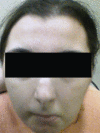Rubinstein-taybi syndrome: a female patient with a de novo reciprocal translocation t(2; 16)(q36.3; p13.3) and dysgranulopoiesis
- PMID: 20126353
- PMCID: PMC2815272
- DOI: 10.1590/S1807-59322010000100016
Rubinstein-taybi syndrome: a female patient with a de novo reciprocal translocation t(2; 16)(q36.3; p13.3) and dysgranulopoiesis
Erratum in
- Clinics (Sao Paulo). 2011;66(11):1999
Figures
Comment in
-
Further peer review failures.Clinics (Sao Paulo). 2011;66(10):1833. doi: 10.1590/s1807-59322011001000025. Clinics (Sao Paulo). 2011. PMID: 22012059 Free PMC article. No abstract available.
References
-
- Rubinstein JH. Broad thumbs-hallux (Rubinstein-Taybi) Syndrome 1957–1988. Am J Med Genet Supplement. 1990;6:3–16. - PubMed
-
- Hennekam RCM, Stevens CA, Van de Kamp JJP. Etiology and recurrence risk in Rubinstein-Taybi syndrome. Am J Med Genet Supplement. 1990;6:56–64. - PubMed
-
- Wiley S, Swayne S, Rubinstein JH, Lanphear NE, Stevens CA. Rubinstein-Taybi syndrome medical guidelines. Am J Med Genet. 2003;119A:101–10. - PubMed
-
- Stevens CA, Carey JC, Blackburn BL. Rubinstein-Taybi syndrome: a natural history study. Am J Med Genet Suppl. 1990;6:30–7. - PubMed
-
- Bloch-Zupan A, Stachtou J, Emmanouil D, Arveiler B, Griffiths D, Lacombe D. Oro-dental features as useful diagnostic tool in Rubinstein-Taybi syndrome. Am J Med Genet A. 2007;143:570–3. - PubMed
Publication types
MeSH terms
LinkOut - more resources
Full Text Sources




